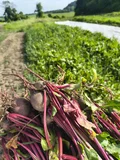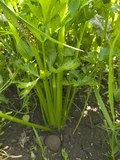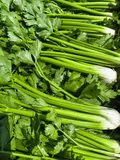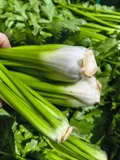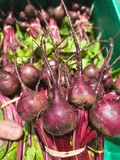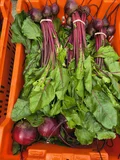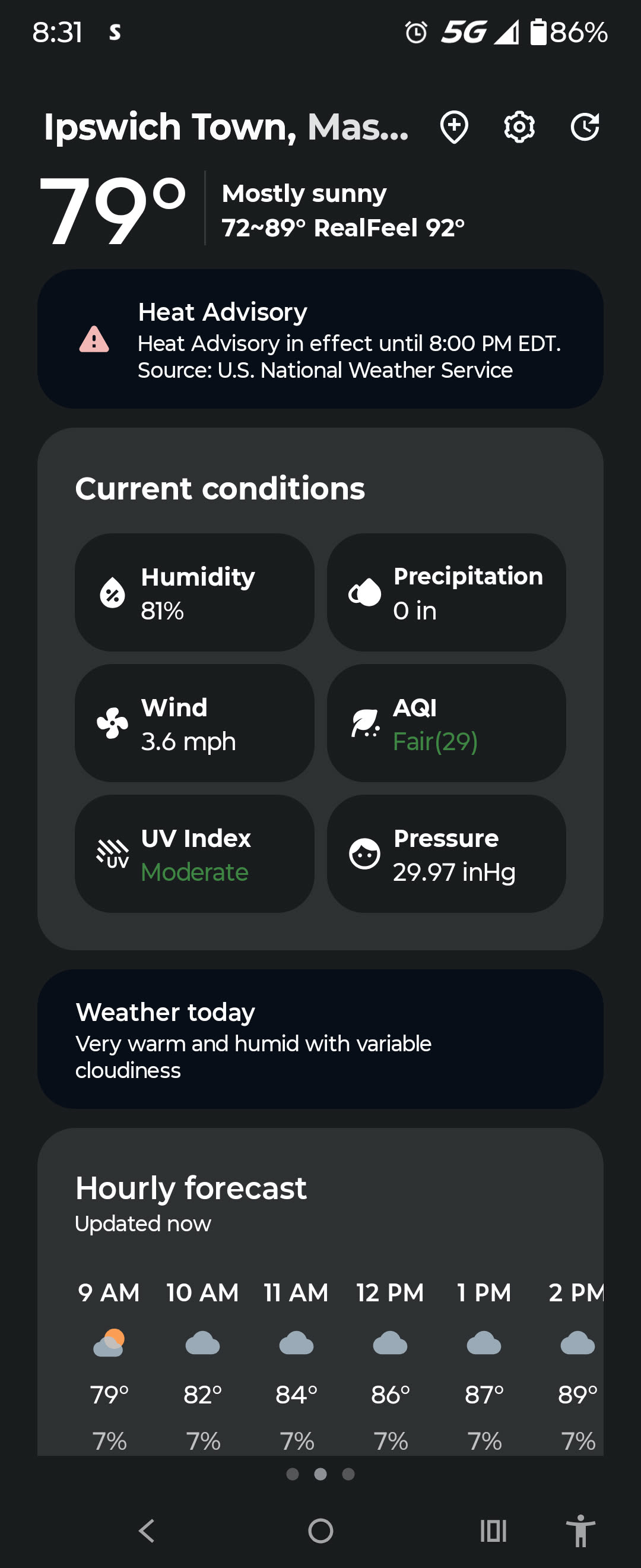TL;DR
We harvested a lot of beets today, a lot…5-6 crates worth. And some early celery came out too. The greenhead flies and mosquitoes were relentless under the 90 degree sun. It was a long Monday after a long weekend and I had time and impetus to reflect on my tech career to-date.
Hot Day, Lots of Bugs
Though we spend most of the morning harvesting beets and early celery, we also had to battle bugs while repairing and baiting the deer fence. Unsteady footing, 90 degrees in the sun, hands covered in peanut butter so I couldn’t easily wipe the sweat off my face, greenhead flies and mosquitos biting all day…let’s just say I was happy to get home and take my shower.
The upside is that we are getting different produce in our CSA shares this and next week. And some early tomatoes are being collected too, but we have to dial in the watering schedule to keep them from nutrient deficiency and root rot (cracking in the fruit and yellowing leaves). The ones in the new greenhouse are very different in their needs apparently than the typical field tomatoes.
Dancing to the Beet
Beets are an under-rated vegetable. While most people go directly for the bulbous root, I prefer the greens which are so packed with iron and other minerals that they taste meaty to me. They’re also crispy and gorgeous when cut into a salad of lettuce and kale.
Sodium, Boron, Potassium, Magnesium, Manganese, and Potassium are all very concentrated in both root and greens. Because the chicken coops are sat over these fields the prior season, we don’t have to fertilize much with the usual ProGro 5-3-4. Chicken manure is very high nitrogen and calcium so these beets grow quite well with minimal interference.
Yah, We Got the Beet
Harvesting these beets has been a multi-week process. At first when the weeds weren’t bad, we were able to go through and pick the golf ball to baseball sized ones which makes room for the smaller ones to grow. This process disturbs the root system a little but not enough to stunt the remainder’s growth.
Because we use Johnny’s Select Seeds almost exclusively, these beets are the classic deep red/fuchsia color. I will check whether they are Boro, Merlin, or Red Ace tomorrow since Jamie direct seeded them and thus I did not encounter them in the greenhouse of course. If I had to guess now, it would be the Merlin variety.
Beeting the Career Gong
There are two consistent things that occur to me as I’m doing monotonous and/or sweat-inducing tasks on the farm about my prior tech career:
- Though the farm work may sometimes feel like economic exile in the wilderness from a quarter-million dollar tech job, it’s really not. It’s a paradise compared to the Machiavellian behaviors I had to navigate almost every day since the summer of 2023.
- Potential employers that can’t figure out any way to hire me really have their heads up their asses. I am very skilled and hard working, care about others, and improve continuously. If that’s too much for someone to handle, they’re not worth working for.
I declined one job offer last year since really seriously putting the petal to the metal on my job search in November, otherwise it’s been a few really close misses due mostly to similar candidates already further down their funnel. Almost three hundred job applications since last May and I am convinced that LinkedIn and other job sites are too broken to be useful.
I was talking with a friend the other day about what they used to do when they lived in China. They said they were a general manager of their uncle’s store and that the practice of hiring family members was common. Though much of the tech hiring pipeline I’ve experienced would otherwise consider using an ‘in’ like this to get a job unethical, I’m convinced that it is in fact a major factor in getting hired these days. Not just a referral, the key is someone who has authority and the confidence to highly recommend you, if not outright hire you into a role.
I’ve been a software engineer for 25 years and have never had to have a referral. Professionally, I’ve been a sales engineer working closely with customers for a decade. I ran an incubation engineering team for 3 years. I’ve been involved in submitting patents, due diligence before acquisitions, strategic long-range planning, overnight large-scale hand-holdings with customers, trainings, and ran a mentorship group for years. Don’t tell me I’m ‘overqualified’ to make $150k, please.
I hand-craft much of my own custom software and processes in my homelab, and have a better understanding of “AI”, specifically use of machine learning models and LLMs, in context of real world use cases than many of my contemporaries. I’ve encountered many of the common pitfalls of AI adoption and have a deep understanding of the limitations of LLMs in practice. Really, cutting edge shit compared to what most of my peers are doing.
And yet, I’m still pulling beets and washing celery. Harvesting knives are my ‘cutting edge’ since March.
Beeting the AI Gong
There are some things that LLMs can do much better than other types of systems. One of which is summarization…when prompted correctly with the right context. I use a mixture of process and ‘context engineering’ to producing the AI-generated summary you see below. It is not zero-effort to implement AI-driven components, and I am getting much better at detecting when things are going wrong earlier in their lifecycle in my homelab.
With this work, I’m not using AI because it is a buzzword…I’m using it to show my technical skill as well as where AI can go wrong. Populists have no idea what they’re talking about and developers just want to keep their jobs. I am encumbered by neither ignorance or greed, just cucumbers (‘encumbered by cucumbers’). If there’s a gong to beat, I’ll do it with a freshly harvested beet.
AI-generated Summary of Field Notes
Consolidated Summary:
Main Themes:
- Farm Labor & Management: Daily tasks like harvesting, cleaning, and scheduling.
- Environmental Challenges: Impact of heat, mosquitoes, and terrain on work conditions.
- Crop Management: Timing and efficiency in harvesting seasonal crops (e.g., onions).
- Pest Control: Use of peanut butter as a deterrent for deer.
- Physical Labor: Strain from heat and repetitive tasks.
Key Activities:
- Harvesting beets and other crops.
- Washing and preparing celery.
- Cleaning the barn and maintaining field infrastructure.
- Mending fences using peanut butter as a repellant.
- Documenting field conditions (e.g., mosquito density, breeze patterns).
New Observations:
- Organic celery has distinct qualities.
- Peanut butter effectively repels deer but may require long-term monitoring.
- Field terrain and microclimates (e.g., breeze patterns) affect work efficiency.
- Seasonal crop cycles demand optimized scheduling.
Research Questions:
- How effective are alternative deterrents for deer?
- Can field conditions (e.g., mosquito density) be improved?
- How does heat impact worker performance and safety?
- Can fence mending strategies be optimized for long-term deer control?
Suggested Actions:
- Test alternative deer repellents (e.g., scents, barriers).
- Improve field accessibility (e.g., mow edges, install drainage).
- Monitor deer behavior around fences to assess peanut butter’s long-term efficacy.
- Optimize harvest schedules to avoid overwork during peak seasons.
- Study field microclimates to tailor work conditions.
This summary integrates the original breakdown into a cohesive overview, highlighting key findings, tasks, and future directions for the farm.
Part 1
Main Themes:
- Farm Labor and Harvesting: Daily tasks involving crop harvesting, sorting, and storage.
- Environmental Challenges: Heat, mosquitoes, and uneven terrain affecting work efficiency.
- Crop Management: Importance of timing and quality in harvesting beets, celery, and scallions.
- Pest Control: Use of peanut butter as a deterrent for deer to prevent fence damage.
- Physical Labor: Demanding physical tasks requiring endurance, balance, and hydration.
Activities Performed by the Intern:
- Harvested and bunched beets (morning and afternoon).
- Washed and bunched celery.
- Cleaned the barn.
- Mended the fence with peanut butter to deter deer.
- Took breaks, had lunch, and managed hydration.
- Documented observations about the field’s conditions (breeze, mosquito activity, terrain).
New Things Encountered:
- Organic Early Celery: Noted its superior flavor compared to regular celery.
- Peanut Butter as Deer Deterrent: Used to train deer to avoid the fence.
- Field Terrain Challenges: Unstable footing, no mowed edges, and varying breeze patterns.
- Deer Behavior and Fence Training: Understanding how deer learn to avoid electrified fences.
- Seasonal Crop Overlap: Beets and onions are both harvested in high volume during peak seasons.
Questions and Future Research Areas:
- Effectiveness of Peanut Butter Deterrent: How does the peanut butter method compare to other deer deterrents?
- Field Conditions Impact: How do breeze patterns and mosquito density affect worker productivity?
- Crop Timing and Quality: What factors influence the peak harvest of beets and onions?
- Deer Behavior Monitoring: Can the fence mending strategy be optimized for long-term deer control?
- Heat and Labor Efficiency: How does high heat impact worker performance and safety?
Suggested Actions:
- Test Alternative Deterrents: Experiment with other scents or methods for deer repulsion.
- Improve Field Accessibility: Consider mowing field edges or installing drainage to reduce mosquito density.
- Monitor Deer Behavior: Track deer activity around the fence to assess the peanut butter method’s long-term effectiveness.
- Optimize Harvest Scheduling: Plan for peak crop seasons (e.g., onions) to avoid overwork.
- Study Field Microclimates: Analyze how breeze patterns and terrain influence work conditions.
[end of post]
Enjoy Reading This Article?
Here are some more articles you might like to read next:
